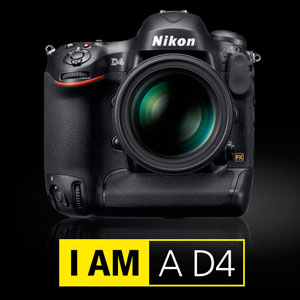
There are two types of camera reviews — ones written by people who use them and ones who obsess over numbers on spec sheets. If you see a review which begins by comparing megapixels, you know you’re looking at the latter type. And since the Internet is full of those kinds of reviews about the Nikon’s newest flagship model — the D4 — I wanted to share two stories with you which will illustrate things you probably haven’t yet heard about the D4 — from a perspective of someone who uses it every day.
The Need for Speed
Have you ever used a computer that feels like it’s constantly lagging behind you? You’ve clicked on a menu, but nothing happens immediately because the machine is busy trying to make sense of the data you’ve just inputted.
I’m sure you’ve used a camera like that, too. You press the shutter, but it doesn’t fire because the autofocus doesn’t have enough light or contrast to work with. It’s just hunting for focus — slooooowly — as it spools the lens barrel with at same pace as a typical pensioner drives his car. Baaaaaaack and fooooorth. By the time it’s ready, the moment is gone.

You then engage autofocus as you widen the focal length to keep the subject in frame. The focus is almost there. Fire — but the facial expression was not the best.
Fire again — nothing happens.
You’re mushing the shutter button like a madman, hoping it fires another frame before the subject goes past you… but the autofocus can’t keep up with this subject. And the moment is gone again.
The Nikon D4 is the antithesis to those kinds of situations.
If you’re a shooter with a need for speed, this is the right tool for the job. It’s relentless and laser-beam accurate as it intuitively hunts for focus at blazing speed, then locks focus and keeps firing at the moving target, adjusting focus and exposure with über-accuracy in the milliseconds between each shot.
If you’re a wedding, newspaper or, like me — a family portrait photographer — where your subject have a tendency to move unpredictably and quickly — in the midst of complex scenes that easily confuse ordinary autofocus systems –, then the Nikon D4 will help you get a sharp photo, properly exposed, every time.
No need to double-check to make sure you got it. If it fired, you know you got it.
Ever since I started using the D4 I pretty much stopped looking at the back of the LCD during shoots. It’s just like being back in the days of film again.
The Big Drop
About a year ago I was faced with a choice — get the perfectly capable Nikon D800 or spend extra on the D4. At the time it was hard to justify almost double the price for a camera which, on paper, didn’t look twice as capable.
A few weeks ago I found out where that money goes when, during a fast photoshoot, I dropped the D4 onto concrete from about a waist height. It crashed against the ground with that sickening sound that only expensive gadgets make when they hit something.
And to top it all off it didn’t come to a stop immediately; it rolled and bounced along the pavement, hitting it with the expensive 85mm 1.4G lens attached to it, the controls and then finally coming to a rest awkwardly on its back, LCD flat against the concrete.
This is a scenario we all fear and hope it never happens, though if you’re a working photographer (for whom this camera is designed) a drop is more a question of “when” rather than an “if.”
My friends who own motorbikes say something similar — the newbies ride hoping that if they’re careful enough they’ll never come off the bike. The experienced riders accept falls as part of the deal and learn on how to come off properly — so that they’re ready when it happens.
It’s the first time I dropped a camera from a height like that on such an unforgiving surface and, even though I knew that the D4 is designed to take knocks, I only had a glimmer hope about its health as I reach towards it to pick it back up.
I lifted it — no cracks in the LCD. Looked at the lens — no visible cracks (thankfully I had the hood on, which absorbed the hit from that angle). Shook it — nothing rattling inside. Buttons are OK. Pressed the Review button — the LCD comes alive, displaying the last image taken before the fall. Pressed the shutter — autofocus beeps to confirm lock. The camera fires — and an image of the ground underneath me replaced the old one on the LCD.
Like nothing happened. The only reminder of the accident is a permanent white scar in the corner of the black body where the concrete met with metal, stripping the paint.
I’ll Take That
Now, I’m absolutely certain that a lesser camera would not have survived.
And that’s a huge consideration to take into account when choosing one for work .. in real terms (when insurance excesses or replacement units are taken into account) cheaper cameras may not be that much cheaper, after all.
+++ You can order the Nikon D4 from Amazon, B&H or Adorama (kit).


